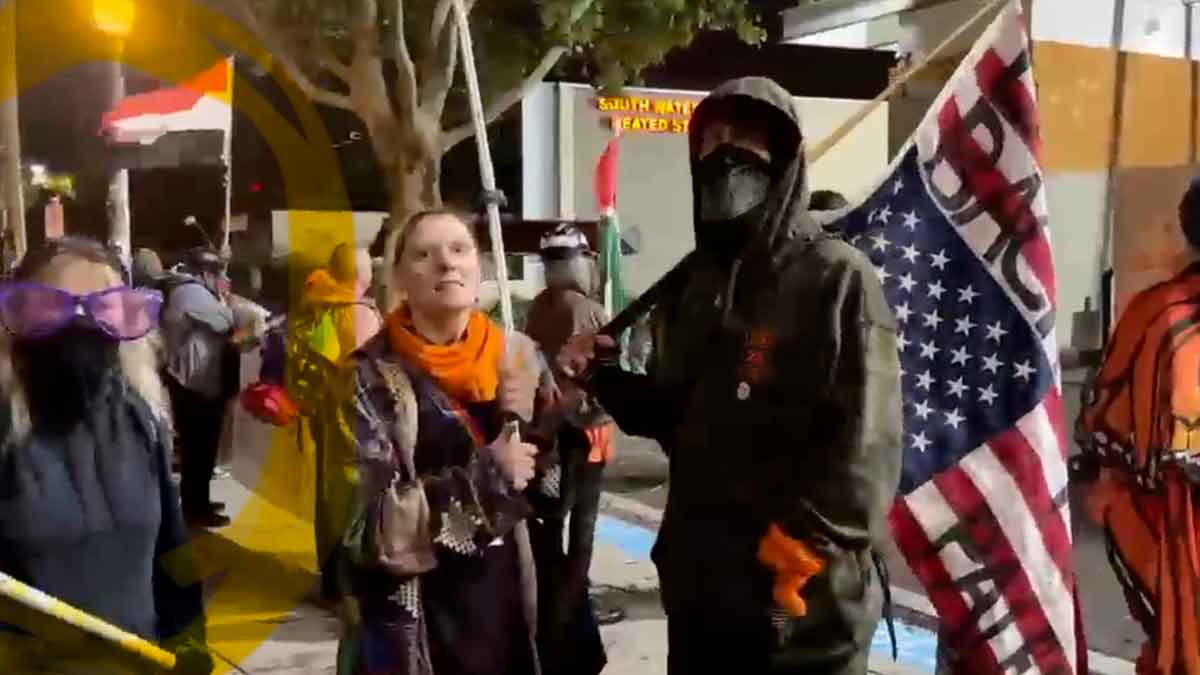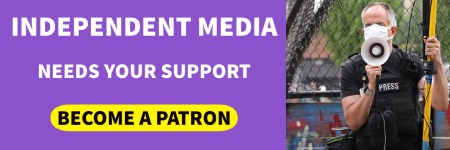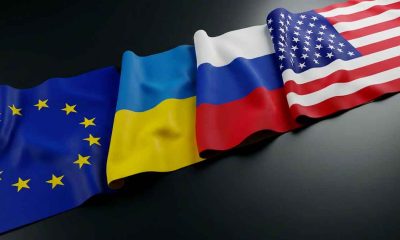Breaking News
Everything You Wanted to Know About Portland Protests
Video showing protesters in Portland being pepper-sprayed is just the latest incident after years of unrest, mostly caused by outsiders.

Breaking News: While this article was in final editing, a federal judge blocked the White House’s request to federalize and deploy 200 soldiers with the Oregon National Guard to Portland.
[Portland, OR – WBHG News] – A video shows a federal agent pepper-spraying two protesters in Portland, Oregon, despite presenting no danger to their safety and after being told to withdraw by a supervisor. It is just one of hundreds of incidents between various groups and police that started in 2018. What happened on Thursday, and why has Portland become a Presidential obsession?
Tensions have increased in the city after President Donald Trump federalized 200 members of the Oregon National Guard, due to months of anti-immigration policy protests in a one-block area of Portland. A flash point for both the political left and right in the United States, the new attention has brought out elements from both sides.
On Thursday, federal agents outside the Immigration and Customs (ICE) office on South Bancroft Street ordered protesters away from the front of the building so a vehicle could exit the driveway. Protesters complied, with several hurling epithets at federal agents as they crossed the street.
The video shows two protesters. An unidentified person wearing a mask and holding a bullhorn, and a 19-year-old who later self-identified by her first name, Leialani. Two federal agents wearing personal protection equipment (PPE) and holding tactical clear plastic riot shields are joined by a third agent with a can of pepper spray.
The video highlights a larger issue that is spreading across the United States, and raises serious questions about the use of force in Portland, potentially being used to further incite protesters.
Analysis of the video
00:03: Leialani is speaking with the two federal agents, who are holding shields, and appears to be using a cellphone to film the interaction. Both agents are relaxed, and neither protester makes any aggressive moves or acts in a threatening way.
00:09: A third agent enters the frame, also wearing a respirator and holding a can of pepper spray.
00:11: The third officer reaches out his right hand toward Leialani, steps between the two holding shields, and says something to her.
00:13: The officer who is holding the pepper spray has moved his thumb over the trigger, is standing in a squared stance, and his left arm stiffens.
0016: The protester with the bullhorn says, “No. No. No. Who is talking to you?”
00:17: A shocked expression appears on Leialani’s face, but it is unclear what was said to her. The officer on the right with a shield takes one small step forward towards her. A supervisor who is not wearing PPE enters the frame. He “taps out” the squad. This is a signal for them to withdraw. In our assessment, the intention was de-escalation. The pair had complied with the earlier order to move away from the ICE building, and the vehicle had already left the driveway.
00:18: The man with the bullhorn says, “This is the [unintelligible] that they created.” The two officers with shields comply with the order, while the third swings his arm holding the pepper spray up.
00:19: Leialani is sprayed in the face at point-blank range even as the other officers withdraw. He moves the stream, spraying her down the neck, then swings left, spraying the masked protester with the bullhorn. Leialani turns around to withdraw, and the officer sprays her head a second time, starting at the crown and down to the center of her shoulders. He then begins to withdraw with the other two officers. The incident lasted three seconds.
00:23: Leialani appears to be blinded, dropping her phone and extending her arms in front of her, taking another step forward, and then stopping.
00:27: At least one person runs in her direction, and the video ends.
What does the federal government say
The Federal Law Enforcement Training Centers’ (FLETC) curriculum and guidelines are available to the public, and Use of Force – Part VI covers the deployment of “intermediate weapons.”
Intermediate weapons are defined as batons, electronic control devices (e.g., Tasers), and oleoresin capsicum (OC – better known as pepper spray). According to established federal training guidelines, “Absent a strong governmental interest, as when the suspect poses a significant threat, intermediate weapons are excessive when any reasonable officer would know that they are likely to cause serious injuries.”
What defines “poses a significant threat?” FLETC applies the Graham Factor, which was established in 1989 by the Supreme Court Case Graham v. Connor. The Graham Factor is a checklist that is used to determine if an officer’s use of force was “objectively reasonable” under the Fourth Amendment of the U.S. Constitution.
FLETC covers how the Graham Factor should be applied by federal officers, opening the section with the guidance that there is “‘No 20/20 Hindsight’ rule.” The section acknowledges that officers may need to make a split-second decision and that the Graham Factor is not a perfect checklist. The factors that need to be taken into consideration include,
- The severity of the crime, which “generally refers to the reason for seizing someone in the first place.” In the simplest terms, the more serious the crime, the lower the bar becomes for using “intrusive” force.
- What is the immediacy of the threat? Is the suspect an “immediate threat to the safety of the officer or others?” FLETC teaches students that this is “considered the most important governmental interest for using force.” While it is unknown what Leialani said to the three officers, the Graham Factor makes it clear that you can’t give someone a face full of pepper spray simply for talking.
- Is the suspect actively resisting arrest? FLETC doesn’t provide specific examples, but it does conclude “Active resistance may also pose a threat.” The video on Thursday shows that the federal officers were not attempting to make an arrest. In this specific case, the third factor does not apply.
- Is the suspect attempting to “evade arrest by flight?” FLETC guidance refers back to the third Graham Factor, advising law enforcement students that flight from arrest is similar to resisting arrest, especially if a suspect is in a “speeding vehicle,” which may pose an even larger threat. As previously noted, no arrest attempt was being made, and the officers had been instructed to stand down by a supervisor. Leailani and the other protesters did not present a flight risk.
FLETC notes that time and the level of threat also need to be considered when applying the Graham Factor to decide when and evaluate the use of force. It uses the example of a robbery suspect suddenly reaching into their waistband, creating a situation in which a law enforcement officer must make a split-second decision. If, after the fact, it is determined that the suspect was unarmed, the officer should be given “more deference” when evaluating their decision.
The lesson adds that “not every situation requires a split-second decision,” and that if someone does not pose an immediate threat, “there is probably time to consider other, less intrusive options.”
The video shows that the officer who pepper-sprayed the two protesters showed intent just two seconds after engaging, and released the OC six seconds later.
How large are the protests, and are the police doing nothing
Portland is 145 square miles (375.5 square kilometers) and has 635,800 residents. The area where the protests have been held since June 9 is roughly 48,400 square feet (4,497 square meters) in an industrial area near the South Waterfront. That’s smaller than a standard football field (or soccer field for our American readers). Since June 15, the largest protest group related to immigration anywhere in Portland has been approximately 100 people, according to federal and local officials.
On Friday, the FBI office in Portland posted on its official Twitter (X) account that since June 9, 130 arrests have been made by federal agents, and there are 27 open investigations. On Thursday, two “citations” had been issued. The data presented by the federal government does not support the ongoing narrative of a lawless state where no arrests are being made or that the current group of federal agents has lost control. During the same period, the Portland Police Bureau has also made dozens of arrests and issued numerous citations.
The ICE office on South Bancroft Street has been a hot spot for protesters for almost a decade, as has the city of Portland. The Department of Homeland Security and the White House declared the situation a “siege,” as justification for the current crackdown and the paused deployment of 200 federalized National Guard soldiers.
Hundreds of videos show that while protests have occurred every night since June 9, during the day, there are often no protesters present, and ICE operates out of the building unhindered. Merriam-Webster defines siege as “a military blockade of a city or fortified place to compel it to surrender; a persistent or serious attack.”
The ICE office in Portland is not blockaded nor under persistent attack. Agents show up for work every day and enter and exit the building, even when groups of more aggressive protesters are present at night.
Most protesters aren’t from Portland and don’t care about civil rights
According to a 2020 report by the Armed Conflict Location and Event Data Project, Oregon is one of the top five states at high risk for “increased militia activity.” This includes anti-government movements, armed militias, neo-Nazis, Christian nationalists, insurrectionary anarchists, sovereign citizens, and so-called people’s rights movements. The ideology of these groups includes far-left and far-right extremism. Almost all of the groups are based outside the Portland area and across the Columbia River in southwest Washington.
Open street brawls between groups such as the Proud Boys, Patriot Front, and Patriot Prayer, versus self-identified anti-fascists, started in 2018.
The three most serious arrests and convictions in Portland from the 2020 Black Lives Matter protests were committed by people who lived outside of Oregon.
In 2021, Proud Boy Alan Swinney of Texas was sentenced to 10 years in prison on second-degree assault and unlawful use of a weapon. He has since disavowed his association with the Proud Boys. Tusitala “Tiny” Toese of Washington, a feared Pacific Northwest Proud Boy enforcer, was sentenced to eight years in prison after multiple violence-related arrests.
The federal government also sentenced Malik Fard Muhammad of Indiana to 10 years in prison after pleading guilty to two counts of possessing unregistered destructive devices. The charges stemmed from a September 5, 2020, incident where Muhammad threw a Molotov cocktail at police, which badly burned a protester. According to the District of Oregon U.S. Attorney’s Office, he also provided baseball bats to “members of the crowd.” Muhammad was also associated with 12 other serious incidents in Oregon and Kentucky, which were never adjudicated due to his acceptance of a federal plea deal.
Beyond the three most public examples, the local, state, and federal data show that most people arrested and convicted of serious crimes during protests in Portland, regardless of their political affiliation, aren’t from Portland.
In 2021, our research into the Black Lives Matter protests in Portland and Seattle concluded that the most violent elements causing unrest were primarily accelerationists seeking to dismantle the U.S. government. They used civil rights and the Black Lives Matter movement as a cover to agitate, pit protest groups against each other, and provoke law enforcement to commit acts of excessive force and violence.
Today, some of the same agents of chaos from 2020, including Joey Gibson of Patriot Prayer, streamer IP2 Portland, and Andy Ngo, founder of the Post Millennial, have inserted themselves into the ongoing protests. Ngo, who had been a strong advocate of the Portland Police Bureau in 2020, turned against the city police this week after the arrest of right-wing podcaster Nick Sortor for disorderly conduct.
What is our assessment after reviewing the facts
In our assessment, the video shows a clear use of force violation by federal officers. Our analysts have a clear understanding of the events that led up to the confrontation, the actions of the officers, and a supervisor is clearly documented in the video. The federal government’s training guidance on when and how to apply “intermediate weapons” is publicly available.
The two protesters in the video did not pose a significant threat, nor did they make any gestures or actions that would warrant the split-second decision-making leeway provided in the Graham Factor. The protesters were not detained, subject to arrest, or attempting to flee after committing a crime.
In our opinion
History has shown that the long-term outcomes of any government that begins selectively choosing who is protected under the law and who isn’t never end well.
Ignoring government overreach further encourages political leadership to push boundaries, risking further restrictions on civil rights and protections. The best modern examples of this can be found in Georgia (the country) and Russia.
In Russia, this manifested itself as a political purge of so-called “turbo patriots” that started in late 2023. The term “turbo patriot” was coined by the State Duma and describes nationalists who love Russia so much that they went beyond pledging their support to Putin’s policies. They also publicly called for even more aggressive actions from the Russian government, including addressing corruption, further embracing Christian nationalism, and more militarization.
The crackdown started in August 2023 after the Private Military Company Wagner Group co-founders Yevgeny Prigozhin and Dmitry Utkin died under questionable circumstances. The private jet they and other senior leaders of the PMC were on exploded or was shot down two months after the failed Prigozhin Insurrection.
Following their deaths, dozens of turbo patriots were arrested, with many being issued administrative penalties and receiving short jail sentences and steep fines. Others died under questionable circumstances or fled the country. Numerous social media channels were shut down. Russian military blogger, electronic warfare and communications expert, and non-commissioned officer in the 2nd Army Corps of the so-called Luhansk People’s Republic, Andrey Morozov (Merz), committed suicide in February 2024 after learning he was facing arrest.
The highest-profile individual among the turbo patriots, former FSB Colonel Igor “Strelkov” Girkin, was imprisoned for 4.5 years on extremism and terrorism charges due to a sarcastic social media post in May 2022, which called for expanding the size of the Russian army, or risk losing control of the Crimean Peninsula, illegally occupied by Russia in February 2014. He was also charged with “discrediting the Russian Armed Forces” after calling for an investigation into Russian officers confiscating their soldiers’ bonus pay. His trial was held behind closed doors and declared a state secret, and he was convicted of extremism.
1936 Germany doesn’t provide a warning – 2011 Russia does
When a government becomes authoritarian, its leadership must maintain an atmosphere of fear among the public, using people, vocations, and organizations to create an endless list of enemies of the state. In Russia, this started with comedians and the arts, followed by the media, journalists, teachers, professors, and union leaders. Then it became opposition political parties, activists, and environmentalists. That was followed by Ukrainians, the European Union, and NATO, and then the LGBTQ community and those against traditional family values.
After Russia’s so-called “special military operation” was not welcomed by the Ukrainian people, and the Russian defeats at Kyiv, Kharkiv, and Kherson between March and September 2022, Moscow was forced to turn to partial mobilization to rebuild its military. The same decree that granted the Ministry of Defense the power to mobilize up to two million troops also introduced the so-called “Don’t Say War” laws.
In 2022 and most of 2023, Russia cracked down on any opposition to the Russia-Ukraine War and carried out widespread raids and purges of the LGBTQ community, bars, clubs, and restaurants. Some men who were arrested in the sweeps were forcibly mobilized and sent to stormtrooper units.
In August 2023, Putin initiated the largest political purge in Russia since the time of Joseph Stalin. The Prigozhin Insurrection and the upcoming March 2024 presidential elections drove the Kremlin’s crackdown. Even Russian opposition leader Alexei Navalny, who was sentenced to prison for the second time in 2021, presented a threat. On February 16, 2024, he died in custody from alleged poisoning, less than a month before Russians went to the polls.
Putin’s ongoing purge has included politicians, oligarchs, generals, advisors, and state security leaders, and continues to this day. Members of his inner circle, including Colonel General Ramzan Kadyrov, former Minister of Defense Sergei Shoigu, and the so-called “Putin’s brain,” Alexandr Dugin, are now outsiders.
Since 2023, Russian prosecutors have frequently used the Don’t Say War laws to criminally charge turbo patriots. The most common allegations have been for spreading fake news, discrediting the Russian Federation Armed Forces, supporting undesirable or terrorist organizations, or promoting extremism.
With the pool of turbo patriots starting to dry up, the Kremlin has turned on another internal group, now targeting oligarchs and business leaders. Since the start of the year, 20 business leaders have died under questionable circumstances, and dozens have been arrested for bribery, embezzlement, and fraud.
The situation in Russia is a warning that Americans should heed. Private prison companies CoreCivic and GEO Group won’t blissfully go into bankruptcy if the administration is somehow able to deport every undocumented immigrant in the United States and declare, “mission accomplished.” The administration will need a constant stream of enemies, and the corporations growing rich off the new policies will lobby for their own interests. What is a use of force violation today, could eventually become American turbo patriots being rounded up in a not-so-distant future.
There is another possibility that supporters of the administration should consider. If the current leadership were to be ousted in elections, the same tools and tactics that some are backing today could be used against them, protected under the banner of the law and recent Supreme Court decisions.
Journalism in the United States is under attack. Malcontent News is an independent news agency established in 2016 and a Google News affiliate. To remain independent, we are supported by our subscribers and limit advertising. The easiest way to support our team is to subscribe to our Substack or Patreon.










